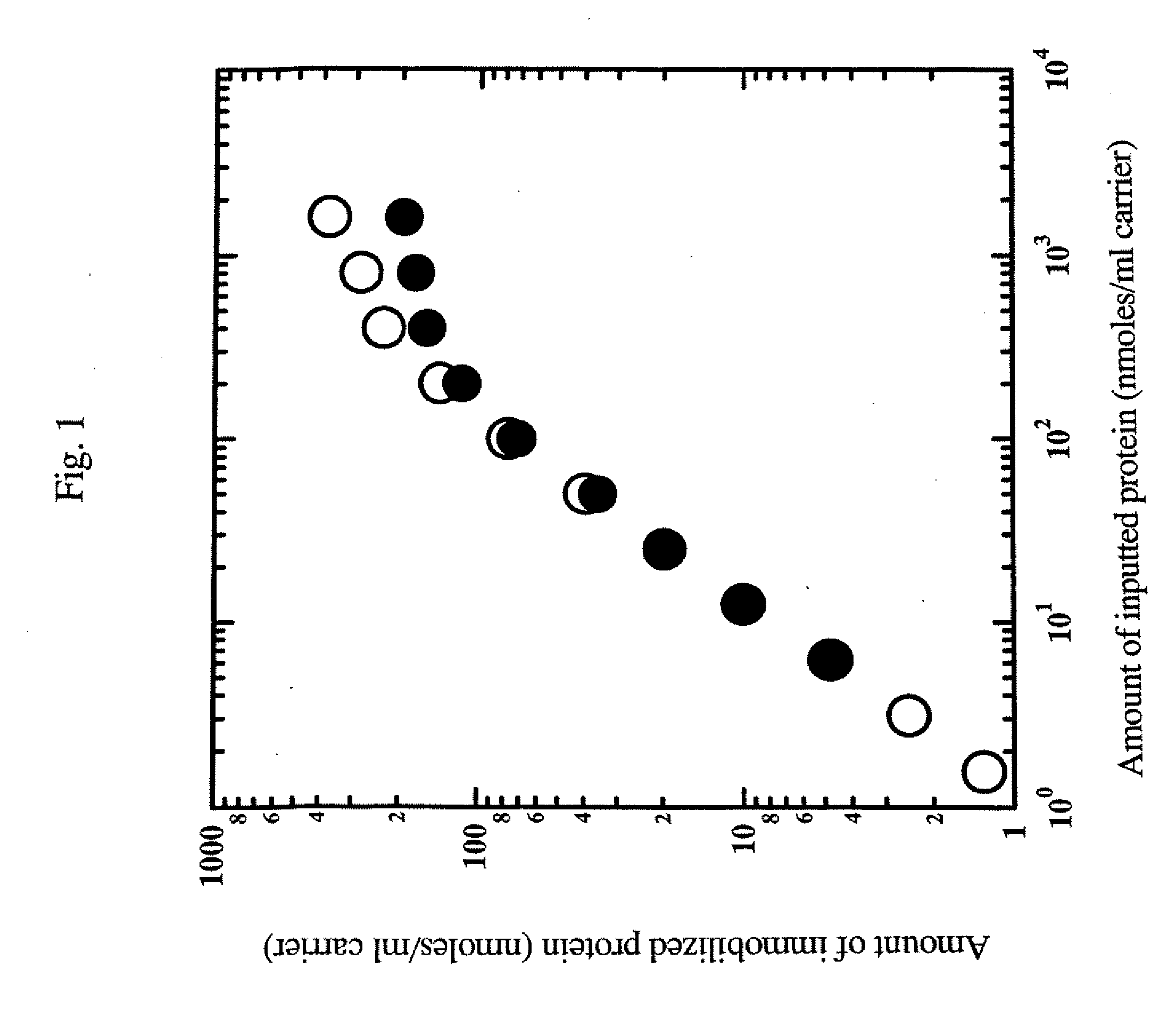Process for immobilizing orientation-controlled protein and process for arraying and immobilizing protein using the same
a technology of orientation control and immobilization reaction, applied in the field of immobilized proteins, can solve the problems of inability to eliminate the possibility of the inability to achieve immobilization at several sites, etc., and achieve the effect of binding
- Summary
- Abstract
- Description
- Claims
- Application Information
AI Technical Summary
Problems solved by technology
Method used
Image
Examples
example 1
Examination of the Immobilization Reaction Using a Green Fluorescent Protein
[0087]A green fluorescent protein (GFP) (SEQ ID NO: 1) was used as the protein corresponding to general formula (1) NH2—R1—COOH to produce a protein to be immobilized (SEQ ID NO: 2) corresponding to general formula (2). Thus, conditions for the immobilization reaction, etc. were examined.
[0088]The fusion protein was immobilized using Amino-Cellulofine (purchased from SEIKAGAKU CORPORATION), and Amino-Toyopearl (purchased from TOSOH) was used as a primary amine carrier.
[0089]Immobilization was carried out in the following manner.
[0090]Each protein had previously been dialyzed with a 10 mM phosphate buffer (pH 8.0) containing a 1000-fold amount of 5 mM ethylenediaminetetraacetic acid (EDTA) three times or more, and the dialyzed protein sample was diluted with a buffer, which was the same as the one used in the dialysis. Thus, protein samples at various concentrations were prepared.
[0091]The thus prepared prote...
example 2
[0105]Comparison of functionalities between the immobilized protein obtained by cyanation after adsorption on a carrier and the immobilized protein obtained by cyanation followed by adsorption on a carrier
[0106]Immobilization was carried out in two ways, i.e., a conventional process wherein a green fluorescent protein is cyanated before being adsorbed on the carrier for immobilization, and the process of the present invention wherein the protein to be immobilized represented by general formula (2) is adsorbed on the carrier for immobilization, followed by cyanation. Thus, the efficiencies of immobilization for the both processes were compared and evaluated.
[0107]A process of cyanating before adsorption was carried out in the following manner according to the process described in Japanese Patent No. 3047020.
[0108]In a 0.1M tris hydrochloride buffer (pH 7.4) containing 5 mM ethylenediaminetetraacetic acid (EDTA), a fivefold amount of 2-nitro-5-thiocyanobenzoic acid (NTCB) was added to...
example 3
Dependence of the Immobilization Efficiency on the Carrier for Immobilization
[0117]Commercially available bead carriers for immobilization, Amino-Cellulofine, Amino-Toyopearl, AH Sepharose, and Polyallylamine Beads were used as carriers for immobilization, and a green fluorescent protein (GFP) was used as a protein to be immobilized to perform immobilization. Immobilization was carried out in the same manner as described in Example 1. The ratio of immobilization was investigated in the same manner as described in Example 1.
[0118]Table 2 shows the maximal immobilization efficiency for each of the carriers.
TABLE 2Measurement using GFPMaximal ratio ofKind of carrier for immobilizationimmobilized protein (%)Amino-Cellulofine81.4Amino-Toyopearl82.9AffiGel 10282.8EAH-Sepharose 4B66.5Porous 20 NH76.8
Except for Amino-Cellulofine and Amino-Toyopearl, values were obtained under conditions of up to 10 nmole / ml of carrier.
[0119]The results shown in Table 2 indicate that the protein can be immob...
PUM
| Property | Measurement | Unit |
|---|---|---|
| isoelectric point | aaaaa | aaaaa |
| soluble | aaaaa | aaaaa |
| reactivity | aaaaa | aaaaa |
Abstract
Description
Claims
Application Information
 Login to View More
Login to View More - R&D
- Intellectual Property
- Life Sciences
- Materials
- Tech Scout
- Unparalleled Data Quality
- Higher Quality Content
- 60% Fewer Hallucinations
Browse by: Latest US Patents, China's latest patents, Technical Efficacy Thesaurus, Application Domain, Technology Topic, Popular Technical Reports.
© 2025 PatSnap. All rights reserved.Legal|Privacy policy|Modern Slavery Act Transparency Statement|Sitemap|About US| Contact US: help@patsnap.com



